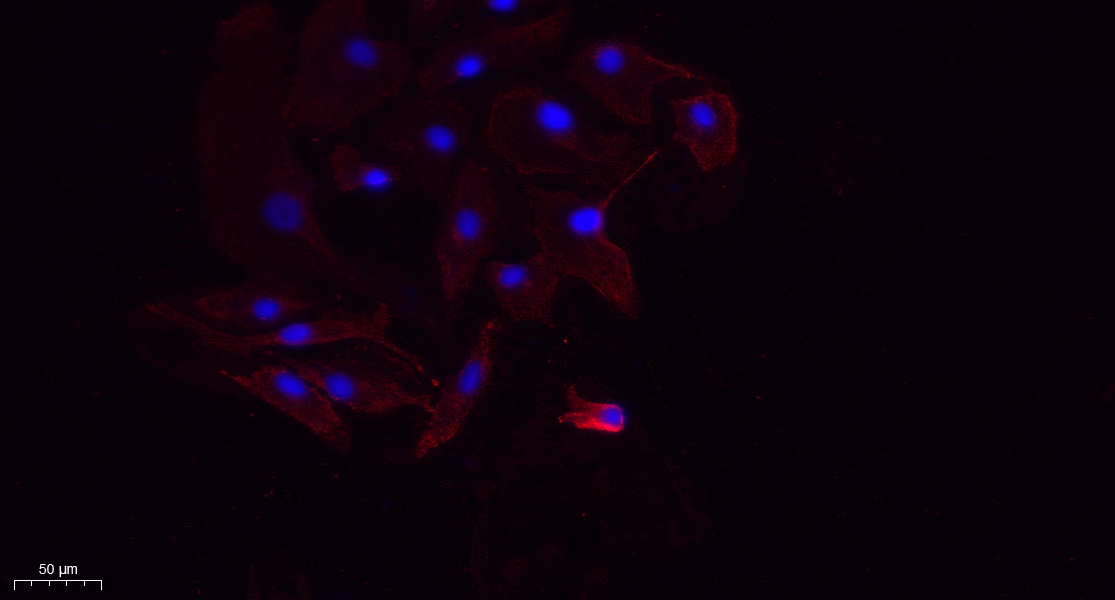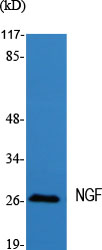NGF Polyclonal Antibody
- Catalog No.:YT3114
- Applications:WB;IHC;IF;ELISA
- Reactivity:Human;Mouse;Rat
- Target:
- NGF
- Fields:
- >>MAPK signaling pathway;>>Ras signaling pathway;>>Rap1 signaling pathway;>>Calcium signaling pathway;>>Cytokine-cytokine receptor interaction;>>PI3K-Akt signaling pathway;>>Apoptosis;>>Neurotrophin signaling pathway;>>Inflammatory mediator regulation of TRP channels
- Gene Name:
- NGF
- Protein Name:
- Beta-nerve growth factor
- Human Gene Id:
- 4803
- Human Swiss Prot No:
- P01138
- Mouse Gene Id:
- 18049
- Mouse Swiss Prot No:
- P01139
- Rat Gene Id:
- 310738
- Rat Swiss Prot No:
- P25427
- Immunogen:
- The antiserum was produced against synthesized peptide derived from human NGF. AA range:33-82
- Specificity:
- NGF Polyclonal Antibody detects endogenous levels of NGF protein.
- Formulation:
- Liquid in PBS containing 50% glycerol, 0.5% BSA and 0.02% sodium azide.
- Source:
- Polyclonal, Rabbit,IgG
- Dilution:
- WB 1:500 - 1:2000. IHC: 1:100-300 ELISA: 1:20000. IF 1:100-300 Not yet tested in other applications.
- Purification:
- The antibody was affinity-purified from rabbit antiserum by affinity-chromatography using epitope-specific immunogen.
- Concentration:
- 1 mg/ml
- Storage Stability:
- -15°C to -25°C/1 year(Do not lower than -25°C)
- Other Name:
- NGF;NGFB;Beta-nerve growth factor;Beta-NGF
- Observed Band(KD):
- 27kD
- Background:
- This gene is a member of the NGF-beta family and encodes a secreted protein which homodimerizes and is incorporated into a larger complex. This protein has nerve growth stimulating activity and the complex is involved in the regulation of growth and the differentiation of sympathetic and certain sensory neurons. Mutations in this gene have been associated with hereditary sensory and autonomic neuropathy, type 5 (HSAN5), and dysregulation of this gene's expression is associated with allergic rhinitis. [provided by RefSeq, Jul 2008],
- Function:
- disease:Defects in NGF are the cause of hereditary sensory and autonomic neuropathy type 5 (HSAN5) [MIM:608654]. The hereditary sensory and autonomic neuropathies are a genetically and clinically heterogeneous group of disorders characterized by degeneration of dorsal root and autonomic ganglion cells, and by sensory and/or autonomic abnormalities. HSAN5 patients manifest loss of pain perception and impaired temperature sensitivity, ulcers, and in some cases self-mutilation. The autonomic involvement is variable.,function:Nerve growth factor is important for the development and maintenance of the sympathetic and sensory nervous systems. It stimulates division and differentiation of sympathetic and embryonic sensory neurons.,online information:Nerve growth factor entry,similarity:Belongs to the NGF-beta family.,subunit:Homodimer.,
- Subcellular Location:
- Secreted . Endosome lumen . ProNGF is endocytosed after binding to the cell surface receptor formed by SORT1 and NGFR. .
- Expression:
- Brain,Epithelium,Eye,Leukocyte,
Loss of ATG5 in KRT14+ cells leads to accumulated functional impairments of salivary glands via pyroptosis
Neuroprotective Effect of Salvianolic Acid A against Diabetic Peripheral Neuropathy through Modulation of Nrf2. Oxidative Medicine and Cellular Longevity Oxid Med Cell Longev. 2020;2020:6431459 IHC Mouse 1 : 500 nerve
- June 19-2018
- WESTERN IMMUNOBLOTTING PROTOCOL
- June 19-2018
- IMMUNOHISTOCHEMISTRY-PARAFFIN PROTOCOL
- June 19-2018
- IMMUNOFLUORESCENCE PROTOCOL
- September 08-2020
- FLOW-CYTOMEYRT-PROTOCOL
- May 20-2022
- Cell-Based ELISA│解您多样本WB检测之困扰
- July 13-2018
- CELL-BASED-ELISA-PROTOCOL-FOR-ACETYL-PROTEIN
- July 13-2018
- CELL-BASED-ELISA-PROTOCOL-FOR-PHOSPHO-PROTEIN
- July 13-2018
- Antibody-FAQs
- Products Images

- Immunofluorescence analysis of A549. 1,primary Antibody(red) was diluted at 1:200(4°C overnight). 2, Goat Anti Rabbit IgG (H&L) - Alexa Fluor 594 Secondary antibody was diluted at 1:1000(room temperature, 50min).3, Picture B: DAPI(blue) 10min.

- Western Blot analysis of various cells using NGF Polyclonal Antibody diluted at 1:2000
.jpg)
- Western Blot analysis of Jurkat cells using NGF Polyclonal Antibody diluted at 1:2000

- Immunohistochemistry analysis of NGF antibody in paraffin-embedded human lung carcinoma tissue.

- Western blot analysis of lysate from Jurkat cells, using NGF antibody.



